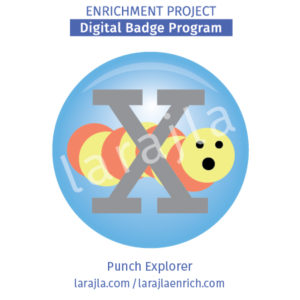
Using punches for crafting allows you to provide more projects for younger kids as they can punch shapes instead of using scissors. Paper punches may look to be expensive, but as you explore all the things you can do with them, they become a better investment.
Steps
1. Types.
Take a trip to your local craft store, discount store or even explore punches online. Shapes and designs cover everything from standard shapes to intricate designs. You might find a cute animal or flat flower you like. You’ll also notice that some come in multiple sizes. If you see any that you think you might be able to use, note where you saw the punch, the manufacturer and what it’s called . . . or you can just take a photo of it to make it easy to remember so you can purchase it later.
2. Basic.
Punches cut a shape out of paper. The way they do this varies by manufacturer. You might press down with your hands flat on the punch, pinch a mechanism or even use your hand to squeeze handles. Try the different punches available. Find out which type(s) you prefer to use.
3. Edges.
Some punches are designed to punch corners or even borders. These punches are designed to allow you to line up and punch a consistent pattern. Explore these types of punches.
4. Storage.
You might think storage will be a breeze because most punches are small. The weight needs to be a consideration as well. As you explore different punches, pick them up and get an idea of how much they weigh. Consider different storage solutions for your punches.
Using Paper Punches
5. Use.
Punches are easy to use. Slide your paper in, push / pull it and out pops your shape. You may be required to use a hard flat surface for some punches. Some of the larger punches don’t work as well and you need to stand on them. Standing offsets the pressure necessary to go through the paper due to the large cutting area. This may also be true with more intricate punches as well. Borrow or purchase a punch to try it yourself.
NOTE: Do not use intricate punches on thicker papers or materials.
6. Material.
All paper is not created equal. Thinner papers such as mulberry paper and vellum do not punch well. Try including a sheet of copy paper to help stabilize it. Thicker papers may not fit into the punch so you may need to punch a shape from thinner paper and use it for a template.
Other materials you can cut with a punch include:
- Polymer clay
- Acrylic paint sheets
- Sticker paper
- Photographs
- Fabric (after stiffened)
- Thin aluminum cans
- Thin plastics
If you choose to experiment with these, be aware that you may destroy your punch in the process so start with a punch you can replace or if you have duplicate.
7. Maintain.
When you get a new punch, sometimes it is stiff and doesn’t want to work. It may even get stuck when you punch paper and you can’t get the paper out. Try these steps to get it working.
- Work the mechanism until it functions properly without paper
- Punch wax paper (lubricant)
- Place in freezer for a while
Also, if your punch gets stuck, you can press the die area back into place or thump it gently on the floor to loosen it and knock it back into place. Be sure that the punch is flat when it hits the floor.
8. Sharp.
Keeping your punches in good working order is important. If you notice rough edges on your paper or not cutting properly, try these steps.
- Punch through wax paper
- Punch through aluminum foil
- Punch through aluminum can
9. Position.
To help accuracy with your punching, punch so you can see what you’re punching out. This might mean punching upside down. This is especially important if you’re punching photographs or a pattern where you want to capture a special area. Remove the plastic bottom if your punch has one to allow you to see.
10. Scraps.
After punching out your favorite duck, you might be tempted to throw the leftover paper away. You can use the cutout for a different effect by simply putting a different colored paper behind the cutout. Use your cutouts in a craft project such as iris folding. In addition, punching the rest of the paper can give you shapes to work with without punching in the future.
11. Track.
One big problem is purchasing duplicate punches. When using your punches, punch an extra and make cards or put them in a notebook so that you have a record of what you own. Be sure to take your tracker with you when you want to purchase punches so you know what you already have.
NOTE: If you’re teaching classes, having more than one punch may be beneficial. I have multiple 1” circles for this purpose.
Badge and Supplement Files
Member Level
- 0EP_B_BPG_PunchX_2in_12up_MS1_larajla — generic badge printable
- 0EP_BLIST_PunchX_MS1_larajla — badge items per membership level
- 0EP_BSET0_PunchX_MS1_larajla —badge set and related badges
- 0EP_SUPP0_PunchX_Journal_MS1_larajla — badge journal
- 0EP_SUPP0_PunchX_Planner_MS1_larajla — badge planner
- 0EP_SUPPL_PunchX_MS1_larajla — supplements currently available per membership level
Supplement Fun
- N/A
Sites to Explore
- www.livecreativelyinspired.com/how-to-sharpen-paper-punches
- www.cutoutandkeep.net/projects/using/paper_punch
- gomakesomething.com/ht/thebasics/punchtips
- makeandtell.com/tips-tricks-using-a-paper-punch
- joyslife.com/how-to-use-paper-punches-correctly
- www.whimsy-love.com/2012/09/diy-paper-punch-pendants.html
- www.marthastewart.com/274859/craft-punch-projects/@center/276982/craft-tools-and-projects
- www.bhg.com/crafts/scrapbooking/techniques/cutting/paper-punch-techniques-for-scrapbooking
- thegreenhouseonthehill.blogspot.com/2012/03/soda-cans-and-punches.html
Get the infographic here > larajla blog post
Get the PDFs of the badge program / supplements here